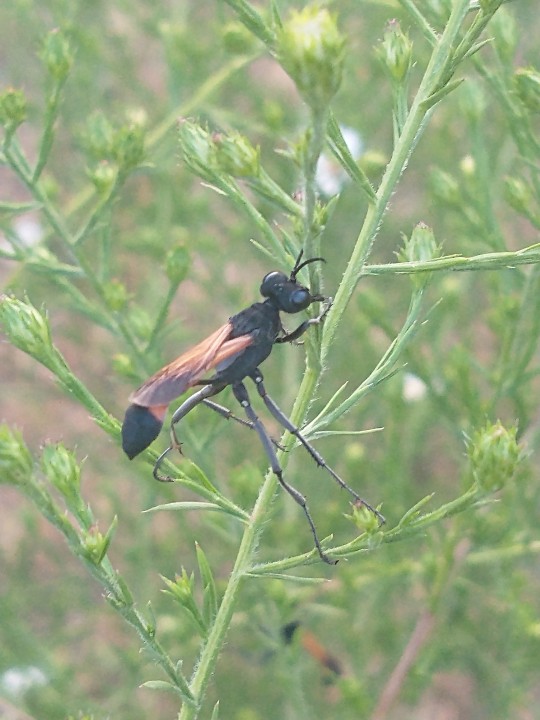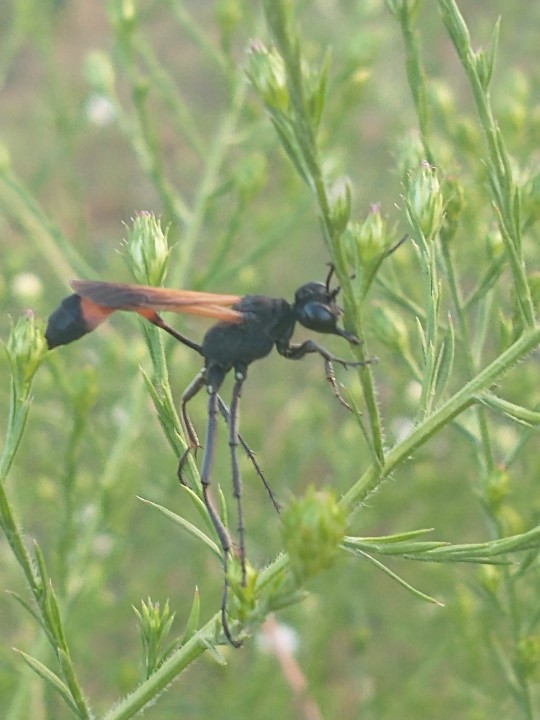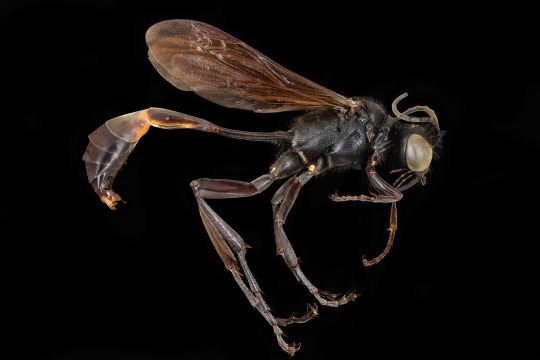#Ammophila pictipennis
Text
@browzerhistory submitted: found a weird guy doin weird stuff in [removed] (remove location pls :3)



i think it's some sort of wasp? there were two or three on the plant, which was an aster. they were all sitting like that, sort of biting the plant, and barely moving except for wiggling their butts and the occasional antennae twitch, even when i got really close to get these photos. there was a bee and a fly acting strangely too - my dad thinks it's just because it was cooling down outside but i'm not sure. any idea what this could be?
This sweet lil friend is a thread-waisted sand wasp, Ammophila pictipennis. They'll grip plants with their mandibles and chill out when it's night time or if it's too cold out. Sort of their version of sleeping. Takin' a lil wasp nap :)
#animals#insects#bugs#submission#wasp#thread waisted wasp#thread waisted sand wasp#Ammophila pictipennis
123 notes
·
View notes
Photo


Carries long squishy things. Ammophila pictipennis. One of several species of North American Thread-waisted Wasps. Hunters of caterpillars and sawfly larvae. Carries them under its body between its legs to a nest in the ground where the wasp's larvae feeds on the paralyzed prey.
59 notes
·
View notes
Photo










Thread-Waisted Wasp - Ammophila nigricans
While I’m here introducing new branches in the Wasp family to this blog by way of Potter Wasps, I found 2 more new species to add to the blog from a different branch. The individual captured in these images is one of those new species. More common Digger Wasps are fairly well known and distinguished to the point of having common names for each of identification. However, Thread-Waisted Wasps are very numerous and have many tiny differences, making identification tough and making distinction through scientific names make preferable. For the identification of this particular specie, look for the placement of the orange section of the abdominal section along with the black-colored wings (for which this insect is named after). Similar looking Wasps may have the orange abdominal segments shifted slightly and their wings tend to be a more orange or brown color. Such examples I found while researching this insect include A. procera and A. pictipennis (both of which are frequently cited as difficult to distinguish.
As the name suggests, this type of Wasp has a particularly elongated wasp-waist and a very slim one at that, almost as if the abdomen has been threaded to the body. Having said that, a number of Digger Wasps are considered “thread-waisted” since their family name Sphecidae refers to that trait. Examine many slim Digger Wasps such as the Blue Mud Dauber or the Great Golden Digger and you’ll agree. Referring to undefined Thread-Waisted Wasps in this context is reserved for the multitude of Wasp in the the subfamily Ammophilinae (sand-loving, referencing their burrowing). This Wasp is one of those. I found this individual crawling around on a long plant blade and it was possibly in search of food to bring to its eggs tucked away in a dirt burrow. Like other solitary Wasps of this type, they leave soft-bodied insects such as Caterpillars for their young, while the adults eat liquid foods. At the moment however, this Wasp wasn’t interested in foraging and merely wanted to rest for the night. Strangely, these Wasps find a tough plant to clamp down on with their mandibles and settle on that plant for the night. While it looks like the legs are supporting the jaws, the head is in fact carrying all the weight during the rest. What strange behavior, but if it were uncomfortable, the Wasp wouldn’t be resting.
*Note: while this Wasp was docile, use your best judgment when allowing a stinging insect to crawl on your palm. Use protection if necessary and take care not to frighten the Wasp or make it aggressive. Digger Wasps are fair more likely to escape than to fight back, but Yellowjackets are another story altogether.
Pictures were taken on August 16, 2020 with a Google Pixel 4.
#jonny’s insect catalogue#insect#wasp#thread waisted wasp#hymenoptera#thread-waisted wasp#toronto#august2020#2020#ontario insect#entomology#nature#invertebrates#arthropods
0 notes
Text
LEB 7(3) 2019
Ecological Factors and the Distribution of Adult Odonata in Puerto Rico by Ariel Diaz, Delwin J. Rodríguez-Flores, Ana G. Rivera-Vega, Edgardo Cruz-Marcano, Iris M. Velázquez-Oliveras, and Luis A. Villanueva-Cubero._LEB 7(3):115-147.
Superparasitism on the Wasp Ammophila pictipennisWalsh (Hymenoptera: Sphecidae: Ammophilinae) by Strepsiptera, with a Record of Observed Instances of Stylopization…
View On WordPress
0 notes
Photo

ammophila pictipennis
13 notes
·
View notes